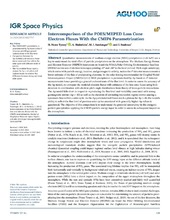Intercomparison of the POES/MEPED Loss Cone Electron Fluxes With the CMIP6 Parametrization
Peer reviewed, Journal article
Published version

Åpne
Permanent lenke
https://hdl.handle.net/1956/23726Utgivelsesdato
2019Metadata
Vis full innførselSamlinger
Originalversjon
https://doi.org/10.1029/2018ja025745Sammendrag
Quantitative measurements of medium energy electron (MEE) precipitation (>40 keV) are a key to understand the total effect of particle precipitation on the atmosphere. The Medium Energy Proton and Electron Detector (MEPED) instrument on board the NOAA/Polar Orbiting Environmental Satellites (POES) has two sets of electron telescopes pointing ~0° and ~90° to the local vertical. Pitch angle anisotropy, which varies with particle energy, location, and geomagnetic activity, makes the 0° detector measurements a lower estimate of the flux of precipitating electrons. In the solar forcing recommended for Coupled Model Intercomparison Project (CMIP) 6 (v3.2) MEE precipitation is parameterized by Ap based on 0° detector measurements hence providing a general underestimate of the flux level. In order to assess the accuracy of the Ap model, we compare the modeled electron fluxes with estimates of the loss cone fluxes using both detectors in combination with electron pitch angle distributions from theory of wave‐particle interactions. The Ap model falls short in respect to reproducing the flux level and variability associated with strong geomagnetic storms (Ap > 40) as well as the duration of corotating interaction region storms causing a systematic bias within a solar cycle. As the Ap‐parameterized fluxes reach a plateau for Ap > 40, the model's ability to reflect the flux level of previous solar cycles associated with generally higher Ap values is questioned. The objective of this comparison is to understand the potential uncertainty in the energetic particle precipitation applying the CMIP6 particle energy input in order to assess its subsequent impact on the atmosphere.
